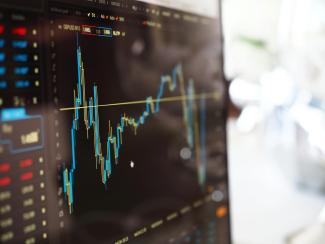
Market Volatility and The SFM Perspective
Market Volatility and Our Perspective
April 8, 2025
Last week, the stock market experienced a sharp and sudden decline following the Trump administration’s announcement of new tariffs. The back-and-forth in trade policy, especially when broadcasted through headlines and media leaks, has created significant uncertainty. Markets dislike uncertainty.
Right now, investors are taking some of the gains they’ve made in the last two years and waiting to see what happens next. Investing at times, feels like you’re driving through a Bar Harbor fog bank where you can’t see the hood of your car. Investor anxiety is high, and so we wanted to send out a note to share some of our thoughts, by no means minimizing this recent decline but to help put some perspective on it.
What’s Happening?
Tariffs are taxes on goods and services, and when they rise significantly or change unpredictably, they can affect how businesses and consumers behave. This leads to consumer confidence falling and then slowing their spending. Which, if sustained, can drag the economy towards or into a recession.
So, while the economy has been strong, investors are responding to the uncertainty surrounding future business slowdowns. This uncertainty resulted in the market dropping by nearly 17% since its all-time highs about seven weeks ago (Feb. 19th), including a fall of 11% in just two days last week, marking the steepest drop since the COVID-19 pandemic. This kind of drop isn’t typical, but it is also not unprecedented.
Putting it in perspective
While the recent decline has been uncomfortable, it’s important to keep a long-term view: Through April
- The US Stock market is now back to the level it was one year ago in May of 2024
- US stocks are up 37% since April 2023
- US stocks are up 138%, or 18.4%/year over the last 5 years
Markets move in cycles. There are ups and downs, sometimes dramatic ones, but over time, stock investments have rewarded patient investors.
Volatility Is Normal
There is a popular measurement of market volatility called the “VIX” index, often called Wall Street’s “fear gauge.” On Monday, April 7th, it closed at 46.98, one of the highest readings in history.
Here’s the important part. Historically, every time the VIX has hit these high levels, U.S. stocks have gone on to rise over the next 1,2,3,4, and 5 years, 100% of the time, and often with above-average returns.
Volatility in stock investing is normal; in fact, a 10% drop happens every 12 to 18 months. Since 2010, there have been more than 30 separate drops of 5% or more. Yet over that same 15-year period, investors who stayed invested saw a 456% cumulative return, or an average of 12.2% per year. The key during volatility is staying the course and not reacting emotionally during turbulent periods, especially since the recovery often comes in large, quick bursts of gains.
Focus on the Fundamentals
Market drops can cause fear. That’s natural. But acting on that fear, like selling stocks during a panic, usually leads to regret. Still, it is important to realize that forecasting is nearly impossible in environments like this. Predicting is inherently tough, and no one can reliably predict what policies, partnerships, or power dynamics will be a year from now, let alone four or five years from now.
So, if we can’t forecast precisely, what can we do? We anchor to probabilities, positioning, and price. Instead of trying to predict, we focus on how assets are priced relative to this new backdrop. Then ask: Is that reasonable? When uncertainty is high, discipline matters more. The best opportunities often arise when others are fearful and hesitant, but you must stay grounded in logic, not emotion.
Also, we think it is important not to confuse falling stock prices with rising risk after they fall. Stocks go on sale from time to time, which is part of investing and part of the normal cycle. The critical question is not, “Will it go lower?” It is: “Am I being compensated fairly for the risk I’m taking?”
Despite the recent news, U.S. stocks are still attractive long-term, and the U.S. remains a strong place to invest. The U.S. has the deepest capital markets, world-class innovation, and regulated investment markets that provide stability and increased clarity on businesses’ financials compared with many other countries. So, while no one can predict the next week or month, history shows that sticking with your plan through uncertain times pays off.
Your Portfolio is Diversified by Design
That being said, we still employ diversification in your portfolios for just this type of volatility. Despite U.S. stocks being a core part of your portfolio, they should be just one piece of the larger picture. Other portfolio assets exist and can continue to do well during volatile times. Some examples of these are
- Bonds or loans to governments and companies that pay interest
- Alternative Investments such as real estate, infrastructure, and private debt.
- Gold can also perform well during times of heightened uncertainty.
These other assets don’t move in lockstep with the stock market. Year to date, all these positions are doing well. Year to date
- Bonds are up and average of 1.85%
- Alternatives are up between 0.5% - 3.5%
- Gold position is up roughly 18%
The benefit of diversification is that not everything goes down when stocks do.
What We’re Doing Now
While we don’t try to predict short-term market moves, there are things we can do to respond strategically.
- Tax Loss Harvesting - Tax-loss swaps are where investors can sell investments currently at a loss and reinvest the proceeds in similar investments that they also may like. Doing this in “taxable” accounts such as trusts, joint, or individual accounts allows an investor to stay fully invested while generating tax losses that you can use next year to offset other gains.
- Rebalance - As investors see a significant decline in stocks within a portfolio, they can leverage the areas like bonds and alternatives that are up to rebalance. This means selling bonds “high” and buying stocks “low”, relatively speaking. This allows you to own more shares of high-quality companies to take advantage of any potential market recoveries.
What Should You Do?
In a word: stay disciplined. Markets go through tough periods, but the U.S. continues to be one of the most attractive places to invest in.
- Focus on the big picture and your financial plan
- Adjust your portfolio when your financial plan changes
- Turn off the news, you’ll just enjoy life a lot more
We remain confident in long-term planning and high-quality investment strategies and are here to help.
The SFM Team
Glenn, Chris, David, Sam, Molly, Melanie


